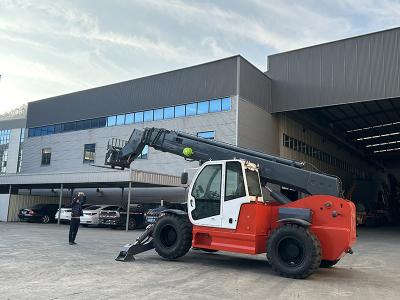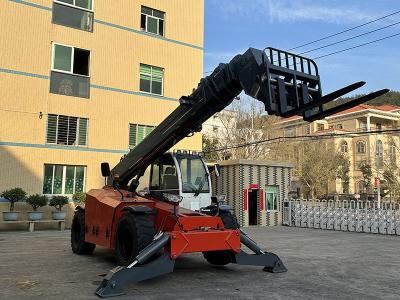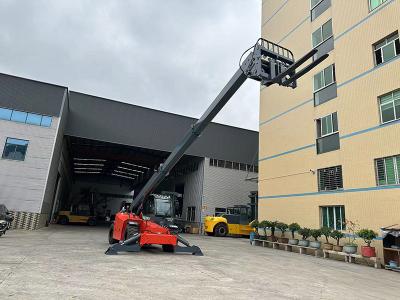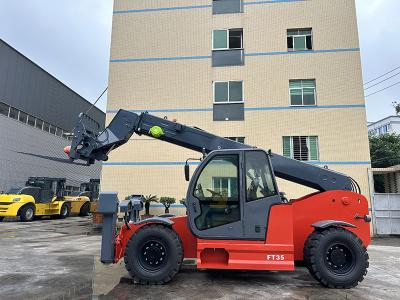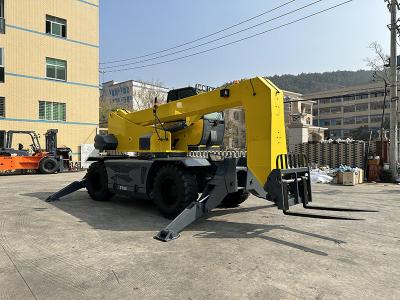Forklifts can usually be divided into three categories: internal combustion forklifts, electric forklifts and warehouse forklifts.
Internal combustion
Internal combustion forklifts are further divided into ordinary internal combustion forklifts, heavy-duty forklifts, container forklifts and side forklifts.
1 Ordinary internal combustion forklifts
Generally, diesel, gasoline, liquefied petroleum gas or natural gas engines are used as power, with a load capacity of 1.2~8.0 tons, and the width of the operating channel is generally 3.5~5.0 meters. Considering the exhaust emissions and noise issues, they are usually used outdoors, in workshops or other places where there are no special requirements for exhaust emissions and noise. Due to the convenience of fuel replenishment, long-term continuous operation can be achieved, and it can be competent in harsh environments (such as rainy days).
2 Heavy-duty forklifts
Using diesel engines as power, with a load capacity of 10.0~52.0 tons, they are generally used for outdoor operations in docks, steel and other industries with heavy cargo.
3 Container forklift
Diesel engine is used as the power, with a load capacity of 8.0~45.0 tons. It is generally divided into empty container forklift, loaded container forklift and container front crane. It is used for container handling, such as container yard or port terminal operations.
4 Side forklift
Diesel engine is used as the power, with a load capacity of 3.0~6.0 tons. It has the ability to directly fork goods from the side without turning, so it is mainly used to take long goods, such as wood strips, steel bars, etc.
Electric
The power is electric motor and the battery is the energy source. The load capacity is 1.0~8.0 tons, and the width of the working channel is generally 3.5~5.0 meters. Because it is pollution-free and has low noise, it is widely used in indoor operations and other working conditions with high environmental requirements, such as medicine, food and other industries. As people pay more attention to environmental protection, electric forklifts are gradually replacing internal combustion forklifts. Since each set of batteries generally needs to be charged after about 8 hours of work, backup batteries are required for multi-shift working conditions.
Warehousing
Warehouse forklifts are mainly designed for handling goods in warehouses. Except for a few warehouse forklifts (such as manual pallet forklifts) that are driven by manpower, the others are driven by electric motors. They are widely used in the warehousing industry because of their compact body, flexible movement, light weight and good environmental performance. When working in multiple shifts, motor-driven warehouse forklifts need to have backup batteries.
The carrying capacity of the transporter is 1.6~3.0 tons, the width of the operating channel is generally 2.3~2.8 meters, and the cargo lifting height is generally around 210mm. It is mainly used for horizontal handling and cargo loading and unloading in the warehouse. There are three operating modes: walking, standing and sitting, which can be selected according to efficiency requirements.
Stacker
Electric pallet stackers are divided into two types: full-electric pallet stackers and semi-electric pallet stackers. As the name suggests, the former is driven and the lifting is electrically controlled, which is more labor-saving. The latter requires manual pulling or pushing of the forklift, and the lifting is electric.
The load capacity is 1.0~2.5 tons, the width of the working channel is generally 2.3~2.8 meters, and the structure has a gantry more than the electric pallet handling forklift. The lifting height of the goods is generally within 4.8 meters, and it is mainly used for stacking and loading and unloading goods in the warehouse.
Forward-moving forklift
The load capacity is 1.0~2.5 tons, and the gantry can be moved forward or retracted as a whole. When retracted, the width of the working channel is generally 2.7~3.2 meters, and the lifting height can reach up to about 11 meters. It is often used for medium-height stacking and picking operations in the warehouse.
Electric picking truck
In some working conditions (such as the distribution center of a supermarket), it is not necessary to ship the entire pallet, but to pick a variety of goods according to the order to form a pallet. This link is called picking. According to the height of the picked goods, electric picking forklifts can be divided into low-level picking forklifts (within 2.5 meters) and medium-high-level picking forklifts (up to 10 meters).
Carrying capacity 2.0~2.5 tons (low position), 1.0~1.2 tons (medium and high position, with cab lifting).
Low-position driving three-way stacking forklift
Usually equipped with a three-way stacking head, the forklift does not need to turn, and the goods can be stacked and picked up on both sides by rotating the goods. The channel width is 1.5~2.0 meters and the lifting height can reach 12 meters. The cab of the forklift is always on the ground and cannot be lifted. Considering the limitation of the operating field of vision, it is mainly used for working conditions with a lifting height of less than 6 meters.
High-position driving three-way stacking forklift
Similar to the low-position driving three-way stacking forklift, the high-position driving three-way stacking forklift is also equipped with a three-way stacking head, the channel width is 1.5~2.0 meters, and the lifting height can reach 14.5 meters. Its cab can be lifted, and the driver can clearly observe the goods at any height and can also perform picking operations. High-driving three-way stacking forklifts are superior to low-driving three-way stacking forklifts in terms of efficiency and various performance, so this model has gradually replaced low-driving three-way stacking forklifts.
Electric tractor
The tractor is driven by an electric motor, using its traction capacity (3.0~25 tons) to pull several small carts loaded with goods behind it. The main categories are: electric tractors for airport logistics, workshop electric tractors, small electric tractors, and electric three-wheel tractors, which are often used to transport large quantities of goods within or between workshops, such as transportation from automobile manufacturing warehouses to assembly lines and luggage transportation at airports.















